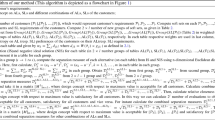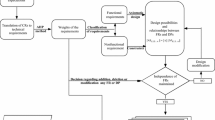Abstract
This work addresses the problem of concept evaluation in uncertain environments of early design stages, with the help of the proposed integrated method involving bijective soft sets, Shannon entropy and technique for order of preference by similarity to ideal solution (TOPSIS). The application of soft set theory in the domain of product design and development is still not being efficiently utilised by previous works. Therefore, the benefit of soft set theory to define the attributes of an object through any type of approximations is used to deal with qualitative description of design criteria, by designers, and the linguistic requirements of customers. Bijective soft sets help the designers to effectively map individual customer requirements to the generated design concepts. With the help of Shannon entropy, customers’ preferences among the identified needs are captured in the new product development process, thus, improving the overall effectiveness of the concept evaluation process. This work considers concept evaluation process as a group multiple criteria decision making problem where, design specifications and customer requirements in qualitative form are first captured by using soft set theory and Shannon entropy and then, this information is incorporated in the framework of TOPSIS to identify the best concept in the evaluation process. The developed integrated method for concept evaluation process is validated with the help of a design illustration, which shows that soft set theory can serve as an effective tool for designers and researchers to reduce the imprecise and vague content of early design stages.

Similar content being viewed by others
References
Akay, D., Kulak, O., & Henson, B. (2011). Conceptual design evaluation using interval type-2 fuzzy information axiom. Computers in Industry, 62(2), 138–146.
Ayağ, Z. (2005a). An integrated approach to evaluating conceptual design alternatives in a new product development environment. International Journal of Production Research, 43(4), 687–713.
Ayağ, Z. (2005b). A fuzzy AHP-based simulation approach to concept evaluation in a NPD environment. IIE Transactions, 37(9), 827–842.
Ayağ, Z., & Özdemir, R. G. (2007). An analytic network process-based approach to concept evaluation in a new product development environment. Journal of Engineering Design, 18(3), 209–226.
Besharati, B., Azarm, S., & Kannan, P. K. (2006). A decision support system for product design selection: A generalized purchase modeling approach. Decision Support Systems, 42(1), 333–350.
Çağman, N., & Enginoğlu, S. (2010a). Soft matrix theory and its decision making. Computers & Mathematics with Applications, 59(10), 3308–3314.
Çağman, N., & Enginoğlu, S. (2010b). Soft set theory and uni–int decision making. European Journal of Operational Research, 207(2), 848–855.
Chen, T. Y., & Tsao, C. Y. (2008). The interval-valued fuzzy TOPSIS method and experimental analysis. Fuzzy Sets and Systems, 159(11), 1410–1428.
Chin, K. S., Yang, J. B., Guo, M., & Lam, J. P. K. (2009). An evidential-reasoning-interval-based method for new product design assessment. IEEE transactions on Engineering Management, 56(1), 142–156.
Ernst, H., Hoyer, W. D., Krafft, M., & Soll, J. H. (2010). Consumer idea generation. Working paper, WHU, Vallendar.
Fogliatto, F. S., & da Silveira, G. J. (2008). Mass customization: A method for market segmentation and choice menu design. International Journal of Production Economics, 111(2), 606–622.
Fuchs, C., & Schreier, M. (2011). Customer empowerment in new product development. Journal of Product Innovation Management, 28(1), 17–32.
Geng, X., Chu, X., & Zhang, Z. (2010). A new integrated design concept evaluation approach based on vague sets. Expert Systems with Applications, 37(9), 6629–6638.
Gong, K., Xiao, Z., & Zhang, X. (2010). The bijective soft set with its operations. Computers & Mathematics with Applications, 60(8), 2270–2278.
Green, G. (2000). Towards integrated design evaluation: Validation of models. Journal of Engineering Design, 11(2), 121–132.
Hemetsberger, A., & Godula, G. (2007). Integrating expert customers in new product development in industrial business-virtual routes to success. Innovative Marketing, 3(3), 28.
Herawan, T., & Deris, M. M. (2011). A soft set approach for association rules mining. Knowledge-Based Systems, 24(1), 186–195.
Hoyer, W. D., Chandy, R., Dorotic, M., Krafft, M., & Singh, S. S. (2010). Consumer cocreation in new product development. Journal of Service Research, 13(3), 283–296.
Huang, H. Z., Bo, R., & Chen, W. (2006). An integrated computational intelligence approach to product concept generation and evaluation. Mechanism and Machine Theory, 41(5), 567–583.
Hwang, C. L., & Yoon, K. (1981). Multiple attribute decision making. In lecture notes in economics and mathematical systems (Vol. 186).
Jenab, K., Sarfaraz, A., & Ameli, M. T. (2013). A conceptual design selection model considering conflict resolution. Journal of Engineering Design, 24(4), 293–304.
Kahraman, C., Büyüközkan, G., & Ateş, N. Y. (2007). A two phase multi-attribute decision-making approach for new product introduction. Information Sciences, 177(7), 1567–1582.
King, A. M., & Sivaloganathan, S. (1999). Development of a methodology for concept selection in flexible design strategies. Journal of Engineering Design, 10(4), 329–349.
Kong, Z., Gao, L., & Wang, L. (2009). Comment on “A fuzzy soft set theoretic approach to decision making problems”. Journal of Computational and Applied Mathematics, 223(2), 540–542.
Kong, Z., Wang, L., & Wu, Z. (2011). Application of fuzzy soft set in decision making problems based on grey theory. Journal of Computational and Applied Mathematics, 236(6), 1521–1530.
Lin, C. T., Lee, C., & Chen, W. Y. (2009). Using fuzzy analytic hierarchy process to evaluate service performance of a travel intermediary. The Service Industries Journal, 29(3), 281–296.
Lin, M. C., Wang, C. C., & Chen, T. C. (2006). A strategy for managing customer-oriented product design. Concurrent Engineering, 14(3), 231–244.
Lin, M. C., Wang, C. C., Chen, M. S., & Chang, C. A. (2008). Using AHP and TOPSIS approaches in customer-driven product design process. Computers in Industry, 59(1), 17–31.
Maji, P. K., Roy, A. R., & Biswas, R. (2002). An application of soft sets in a decision-making problem. Computers & Mathematics with Applications, 44(8), 1077–1083.
Maji, P. K., Biswas, R., & Roy, A. R. (2001). Fuzzy soft sets. Journal of Fuzzy Mathematics, 9(3), 589–602.
Marsh, E. R., Slocum, A. H., & Otto, K. N. (1993). Hierarchical decision making in machine design. Technical report. Cambridge, MA: MIT Precision Engineering Research Center.
Matzler, K., & Hinterhuber, H. H. (1998). How to make product development projects more successful by integrating Kano’s model of customer satisfaction into quality function deployment. Technovation, 18(1), 25–38.
Molodtsov, D. (1999). Soft set theory—First results. Computers & Mathematics with Applications, 37(4), 19–31.
Opricovic, S., & Tzeng, G. H. (2004). Compromise solution by MCDM methods: A comparative analysis of VIKOR and TOPSIS. European Journal of Operational Research, 156(2), 445–455.
Roy, A. R., & Maji, P. K. (2007). A fuzzy soft set theoretic approach to decision making problems. Journal of Computational and Applied Mathematics, 203(2), 412–418.
Sayadi, M. K., Heydari, M., & Shahanaghi, K. (2009). Extension of VIKOR method for decision making problem with interval numbers. Applied Mathematical Modelling, 33(5), 2257–2262.
Shannon, C. E., & Weaver, W. (1947). The mathematical theory of communication. Champaign, IL: University of Illinois press.
Sii, H. S., & Wang, J. (2003). A design—decision support framework for evaluation of design options/proposals using a composite structure methodology based on the approximate reasoning approach and the evidential reasoning method. Proceedings of the Institution of Mechanical Engineers, Part E: Journal of Process Mechanical Engineering, 217(1), 59–76.
Song, W., Ming, X., & Wu, Z. (2013). An integrated rough number-based approach to design concept evaluation under subjective environments. Journal of Engineering Design, 24(5), 320–341.
Tiwari, V., Jain, P. K., & Tandon, P. (2016). Product design concept evaluation using rough sets and VIKOR method. Advanced Engineering Informatics, 30(1), 16–25.
Wang, C. H. (2009). Outlier identification and market segmentation using kernel-based clustering techniques. Expert Systems with Applications, 36(2), 3744–3750.
Wang, T. C., & Lee, H. D. (2009). Developing a fuzzy TOPSIS approach based on subjective weights and objective weights. Expert Systems with Applications, 36(5), 8980–8985.
Xiao, Z., Gong, K., & Zou, Y. (2009). A combined forecasting approach based on fuzzy soft sets. Journal of Computational and Applied Mathematics, 228(1), 326–333.
Zhai, L. Y., Khoo, L. P., & Zhong, Z. W. (2008). A rough set enhanced fuzzy approach to quality function deployment. The International Journal of Advanced Manufacturing Technology, 37(5–6), 613–624.
Zhang, Z., & Chu, X. (2009). A new integrated decision-making approach for design alternative selection for supporting complex product development. International Journal of Computer Integrated Manufacturing, 22(3), 179–198.
Zhu, G. N., Hu, J., Qi, J., Gu, C. C., & Peng, Y. H. (2015). An integrated AHP and VIKOR for design concept evaluation based on rough number. Advanced Engineering Informatics, 29(3), 408–418.
Zitnick, C. L., & Kanade T. (2004). Maximum entropy for collaborative filtering. In ACM proceedings of the 20th conference on uncertainty in artificial intelligence (pp. 636–643).
Zou, Y., & Xiao, Z. (2008). Data analysis approaches of soft sets under incomplete information. Knowledge-Based Systems, 21(8), 941–945.
Author information
Authors and Affiliations
Corresponding author
Rights and permissions
About this article
Cite this article
Tiwari, V., Jain, P.K. & Tandon, P. An integrated Shannon entropy and TOPSIS for product design concept evaluation based on bijective soft set. J Intell Manuf 30, 1645–1658 (2019). https://doi.org/10.1007/s10845-017-1346-y
Received:
Accepted:
Published:
Issue Date:
DOI: https://doi.org/10.1007/s10845-017-1346-y




